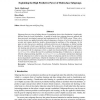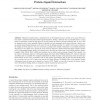851 search results - page 166 / 171 » EIS data: findings from an evolutionary study |
CAD
2005
Springer
13 years 6 months ago
2005
Springer
Heterogeneous structures represent an important new frontier for 21st century engineering. Human tissues, composites, `smart' and multimaterial objects are all physically man...
JMLR
2010
13 years 1 months ago
2010
Subgroup discovery aims at finding subsets of a population whose class distribution is significantly different from the overall distribution. A number of multi-class subgroup disc...
JCC
2011
12 years 9 months ago
2011
: Molecular recognition plays a fundamental role in all biological processes, and that is why great efforts have been made to understand and predict protein–ligand interactions. ...
SIGMOD
2004
ACM
14 years 6 months ago
2004
ACM
In this paper, we attempt to approximate and index a ddimensional (d 1) spatio-temporal trajectory with a low order continuous polynomial. There are many possible ways to choose ...
UIST
2009
ACM
14 years 1 months ago
2009
ACM
Because functional near-infrared spectroscopy (fNIRS) eases many of the restrictions of other brain sensors, it has potential to open up new possibilities for HCI research. From o...


